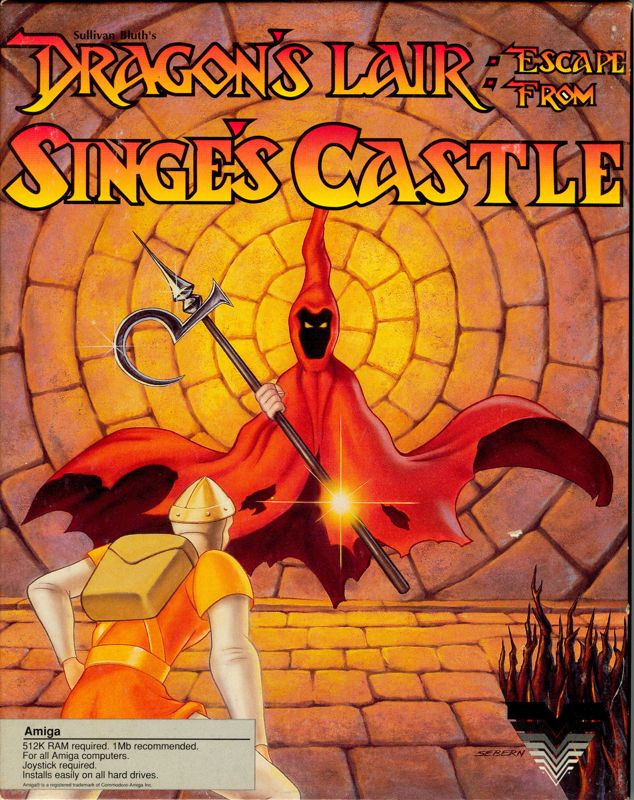Retro Replay Review
Gameplay
Dragon’s Lair: Escape from Singe’s Castle picks up immediately after Dirk the Daring vanquishes the fearsome dragon. As with its predecessor, gameplay is built around precise, timed inputs—often known today as quick-time events. Players must watch Dirk’s on-screen animations and react by pressing the correct direction or action button at the exact moment. Success means watching Dirk elegantly dodge traps, cut down monsters, or leap across chasms; failure usually results in a creative, gruesome death sequence.
(HEY YOU!! We hope you enjoy! We try not to run ads. So basically, this is a very expensive hobby running this site. Please consider joining us for updates, forums, and more. Network w/ us to make some cash or friends while retro gaming, and you can win some free retro games for posting. Okay, carry on 👍)
While the reactive nature of the controls can feel punishing by modern standards, it also adds a layer of thrilling tension. Each corridor, room, or chamber of Singe’s Castle holds a hidden hazard: collapsing floors, swinging axes, and unexpected creatures spring to life when you least expect them. Mastering the timing window requires multiple playthroughs, rewarding memorization and quick reflexes. Fans of arcade-style precision will find this challenge addictive, even if younger gamers might bristle at the steep learning curve.
Because this title was designed for the limited disk and memory capabilities of home computers of the era, the gameplay segments are shorter and more segmented than the arcade original. Each decision point leads instantly to success or failure, keeping the pace brisk. There are no inventory systems or long exploration phases—just an unrelenting stream of split-second choices. For players seeking a straightforward action experience, it’s ideal; those hoping for deeper mechanics might feel underwhelmed.
Despite its simplicity, the game still surprises with clever scenario design. One moment you’re hacking through skeleton guards, the next you’re scaling treacherous walls as the ceiling collapses. The variety of traps and foes, combined with unpredictable timing, keeps each playthrough fresh. Even after learning the correct commands, anticipating the next peril gives a satisfying rush.
Graphics
The visual centerpiece of Dragon’s Lair II is its hand-drawn animation, originally crafted by Don Bluth’s studio for the arcade laserdisc. On home systems, these sequences are compressed but still retain much of their original charm. Rich color palettes bring the castle’s torchlit corridors to life, and every background feels like a medieval tapestry straight out of a fantasy novel. Even pixelated, the fluidity of Dirk’s movements stands out against more static offerings of the time.
Given the technical constraints of 8- and 16-bit platforms, some graphical fidelity is lost—but careful palette choices and clever dithering minimize the impact. Certain versions show blocky edges or occasional color banding, yet the overall artistry shines through. Fans will recognize iconic scenes—like the dragon’s lair, the collapsing staircases, and the final princess rescue glowing atop a distant tower. Each frame is a visual treat that evokes nostalgic delight.
Character designs remain bold and expressive: Dirk’s mustached profile, Singe’s fiery breath (in flashback), and Princess Daphne’s wide-eyed grace all translate well. Environmental details—stained glass windows, gargoyle statues, and creeping vines—add depth to the castle’s imposing atmosphere. While there’s no dynamic lighting or 3D polygonal modeling, the hand-painted backgrounds and fluid sprite animations deliver a unique, storybook aesthetic.
Across different ports, one might notice slight color shifts or reduced frame counts, but the core visual experience endures. It’s a showcase of animation prowess more than cutting-edge graphics technology. For retro enthusiasts or collectors curious about gaming history, the visual style alone makes the purchase worthwhile.
Story
Dragon’s Lair II continues the heroic saga of Dirk the Daring immediately after he slays the dragon Singe. In classic fairy-tale fashion, Dirk rushes deeper into the castle to rescue Princess Daphne from her dungeon cell. The narrative is delivered with minimal text—most storytelling unfolds through animated cutscenes and Dirk’s on-screen escapades. Despite its brevity, the tale taps into timeless themes of chivalry, bravery, and true love’s rescue.
The scenarios in Singe’s Castle aren’t just random set-pieces; they’re woven into the narrative of a desperate rescue mission. Every trap is cast as a final obstacle thrown by a vengeful demon, testing Dirk’s resolve. When the knight nearly falls into a pit of lava or is chased by skeleton warriors, the stakes feel personal. You’re not just completing levels—you’re driving forward a simple but heartfelt quest to save the princess.
Though there’s no branching dialogue or multiple endings, the story’s linear structure works in its favor. It maintains a cinematic momentum reminiscent of Saturday-morning cartoons, with each scene teasing the next peril. The game’s halfway split—covered in the earlier port—and this concluding chapter create a two-act drama that feels grand despite hardware limitations.
For those craving deep lore or character development, the spare narrative may seem too thin. However, in the context of its era and arcade origins, the storytelling method—relying on fluid animation and player-driven action—becomes its own charm. Dirk’s silent heroism and the princess’s silent gratitude convey more than words ever could.
Overall Experience
Dragon’s Lair: Escape from Singe’s Castle offers a compact, adrenaline-fueled journey through a perilous medieval fortress. Its strength lies in its pure, reflex-driven gameplay and unforgettable hand-drawn visuals. Modern gamers used to save points, tutorials, or button-mashing combat may find the game’s strict input requirements demanding. Yet for aficionados of retro arcade challenges, each replay solidifies muscle memory and provides a satisfying sense of accomplishment.
The title’s historical significance is undeniable. It represents an era when developers experimented with merging animation cinema and interactive gaming. Playing this second chapter feels like stepping into a vintage animated short—except you control the hero’s every move. It’s a reminder of how constraints can spur creativity, resulting in a product that remains iconic decades later.
In practical terms, the game’s brevity is both a blessing and a curse. A single successful run can be completed in under ten minutes, making it ideal for quick sessions or showcasing at retro gaming nights. However, those looking for dozens of hours of content may be disappointed by its concentrated length. The real draw is perfecting each sequence, learning every trap, and savoring the artful animations.
Ultimately, Dragon’s Lair II: Escape from Singe’s Castle is best suited for collectors, fans of quick-time challenges, and anyone curious about gaming’s early flirtations with cinematic storytelling. It remains a one-of-a-kind experience that captures the imagination with its blend of artistry and action. If you’re prepared for precise timing and appreciate classic animation, this retro gem is well worth adding to your library.
 Retro Replay Retro Replay gaming reviews, news, emulation, geek stuff and more!
Retro Replay Retro Replay gaming reviews, news, emulation, geek stuff and more!









Reviews
There are no reviews yet.